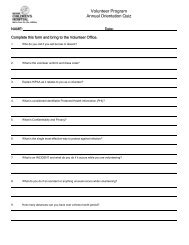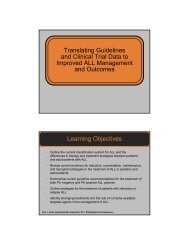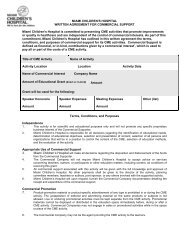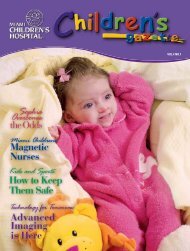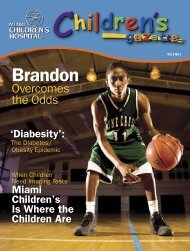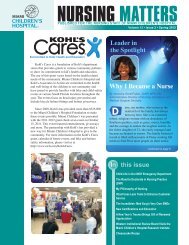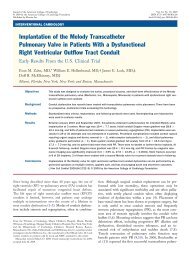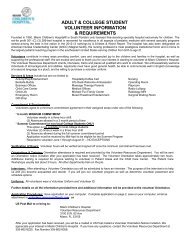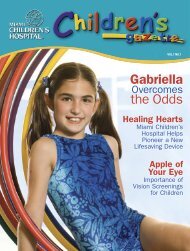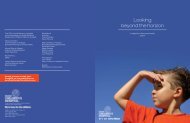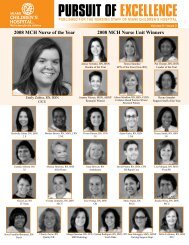PURSUIT OF EXCELLENCE - Miami Children's Hospital
PURSUIT OF EXCELLENCE - Miami Children's Hospital
PURSUIT OF EXCELLENCE - Miami Children's Hospital
You also want an ePaper? Increase the reach of your titles
YUMPU automatically turns print PDFs into web optimized ePapers that Google loves.
<strong>PURSUIT</strong> <strong>OF</strong> <strong>EXCELLENCE</strong><br />
PUBLISHED FOR THE NURSING STAFF <strong>OF</strong> MIAMI CHILDREN’S HOSPITAL<br />
Nurse Leader<br />
In the Spotlight<br />
Dania Vazquez<br />
<strong>Miami</strong> Children’s <strong>Hospital</strong><br />
Mentorship Program<br />
By Leslie Abascal, RN<br />
I<br />
In effort to provide support to new<br />
nurses, <strong>Miami</strong> Children’s <strong>Hospital</strong> is<br />
designing a one-year mentorship<br />
program for the new nurse. The<br />
program is an opportunity for new graduates<br />
to enhance their critical thinking skills<br />
and personal development. Graduates will<br />
Volume 7 • Issue 2 • Fall 2006<br />
to an actual hospital environment to be<br />
challenging and stressful. Each new nurse<br />
will be carefully matched with an experienced<br />
senior nurse. Each new nurse, or mentee,<br />
is encouraged to communicate concerns,<br />
problems, and/or specific goals or career paths<br />
he or she wants to accomplish in the future.<br />
Each mentor and mentee is then encouraged to<br />
agree on methods and ways to communicate,<br />
talk on the phone or email each other on a<br />
regular basis. The mentor and mentee will<br />
provide documentation quarterly to the<br />
Recruitment and Retention committee so that<br />
the success of the program can be tracked.<br />
Education:<br />
• MSN (1999) - Florida<br />
International University<br />
Pediatric Nurse Practitioner<br />
• BSN (1987) - University of<br />
<strong>Miami</strong>, <strong>Miami</strong>, Florida<br />
• ADN (1977) - East Los<br />
Angeles College<br />
Work Experience:<br />
• Began her nursing career at<br />
MCH in 1980<br />
• 2005 – Present: Pediatric<br />
Nurse Practitioner and Clinical<br />
Nurse Specialist in Psychiatry<br />
inpatient unit. Performs history<br />
and physicals for the<br />
admissions of patients. Treats<br />
medical conditions of patients<br />
in collaboration with the<br />
psychiatry attending<br />
physicians.<br />
• 2003 - Present: Pediatric<br />
Clinical Instructor, Adjunct<br />
Faculty; Florida International<br />
University<br />
• 2003 – 2005: Pediatric Clinical<br />
Instructor, Adjunct Faculty;<br />
University Of <strong>Miami</strong><br />
• 2003 - 2005: Clinical Nurse<br />
Specialist, Neurology<br />
and Respiratory Units;<br />
<strong>Miami</strong> Children <strong>Hospital</strong><br />
have the opportunity to receive personalized<br />
support through a one-to-one exchange with<br />
a senior nurse who has volunteered to serve<br />
as a mentor. Mentoring can provide many<br />
benefits, such as bringing together theory and<br />
nursing practice, guidance, career development<br />
and increasing self esteem. A mentor<br />
is a person who embodies the characteristics<br />
that you admire, and is willing to help you<br />
develop those characteristics yourself, so you<br />
can achieve your goals and ambitions. It occurs<br />
through active communication. A mentor<br />
shows a strong commitment to the profession.<br />
A mentor is willing to be a role model and<br />
advocate. The mentor will be able to provide<br />
career guidance, advice and leadership for<br />
beginning nurses who often find the transition<br />
In<br />
this issue<br />
ED Team at Nurse Association Event<br />
Know the Forces: Magnet Forces 3,4 & 5<br />
2006-2008 Magnet Timeline<br />
Practice Update<br />
A Profile of Licensed Practical Nurses<br />
Celebrating Compassion and<br />
Excellence with the DAISY Foundation<br />
Halloween Safety Tips<br />
Freeda Hill-Beck Celebration of<br />
Nursing Event
Nurse Leader<br />
From the Desk of Jackie Gonzalez<br />
Dear Nursing Team:<br />
In the Spotlight<br />
• 2001 – 2003: Pulmonology<br />
Pediatric Nurse Practitioner<br />
• 2000 – 2001: Manager GI LAB,<br />
Pediatric Nurse Practitioner;<br />
<strong>Miami</strong> Children’s <strong>Hospital</strong><br />
• 1997- 2000: Manager Infusion<br />
Unit, Hem/Onc Unit.; MCH<br />
• 1983 – 1990: Worked in various<br />
positions at MCH, including<br />
Hem/Onc unit and clinic and<br />
Gastroenterology Department.<br />
First role at MCH was as a staff<br />
nurse in the float pool.<br />
Quote:<br />
“My passion for nursing has<br />
motivated me to learn and work<br />
in different sub-specialties and<br />
roles. After 20 years in nursing<br />
I went back to school to get my<br />
MSN and become a Pediatric<br />
Nurse Practitioner. Throughout<br />
my years at MCH, I have<br />
collaborated with the Staff<br />
and Community Education<br />
Department for the education of<br />
hospital-wide nursing staff, and<br />
have been a speaker in multiple<br />
lecture presentations.”<br />
Publications:<br />
• 2005 - Collaborated with the article,<br />
A Collaborative Approach<br />
to Expand Clinical Experiences<br />
and Cultural Awareness with<br />
Undergraduate Nursing Students,<br />
published in the Journal<br />
of Professional Nursing 21(4),<br />
240-243.<br />
• 2005 - Q&A Section in the journal<br />
Advance for Nurses (5)<br />
• 2004 - Pediatric Emergencies<br />
in the journal Advance<br />
for Nurses<br />
• 2002 - Collaborated with the<br />
article published in the Clinical<br />
Journal of Oncology Nursing<br />
on The ABCs of Low Blood<br />
Cell Count, (2002).<br />
Family:<br />
Husband, Santiago and three<br />
children, Eric 22, Janell 18,<br />
and Brian,13<br />
In June and July of this year, I talked with many of you about ways to improve<br />
service to the families we serve and to enhance the work environment. The following<br />
are top concerns expressed by all shifts and departments as well updates on<br />
actions taken to improve: (All issues have been discussed with the appropriate director or vice president.)<br />
1. General cleanliness - (including garbage pick up) and delays in the admission/discharge process.<br />
ACTIONS: Kathleen Spence, Manager (3 North) and Pat Wilson, Manager (NICU) met with<br />
Environmental Services to assist in improving our processes. An additional round of garbage pick-up<br />
will be conducted on the night shift, particularly when the hospital is at Code Bed. A discharge team has<br />
been added to the Environmental Services staff during peak periods to admission/discharge cleaning.<br />
2. Computers - down time and availability of Help Desk<br />
ACTIONS: The Spectralink server and phones have been upgraded and should yield more reliability.<br />
To improve wireless connectivity, Bell South is completing a walk-through survey of the entire campus<br />
to identify ways to improve coverage and reliability and plan for future additions. In 2007, the campus<br />
will be completely wireless, not just in patient care areas. All units have been evaluated and monitors<br />
replaced. New PCs are being upgraded and given full functionality for all applications to all the patient<br />
care areas. The Help Desk is adding approximately 72 additional hours per week of staff time for<br />
assistance.<br />
3. Supplies – inadequate supplies particularly on weekends and when products are not available, no<br />
communication mechanism until the need for them arises.<br />
ACTIONS: A supply performance improvement team has been developed to focus on these areas.<br />
The issue of outages of washcloths should be solved as washcloth replenishing was transferred from<br />
Environmental to Materiels Services.<br />
I had the good fortune to attend my last meeting as a member of the Education Council of the National<br />
Association of Children’s <strong>Hospital</strong>s and Related Institutions (NACHRI) in Boston, Massachusetts. I had<br />
such great pride as I walked around the exhibit area to see <strong>Miami</strong> Children’s <strong>Hospital</strong> was listed as being<br />
a member of the Emergency Department and PICU focus groups charged with improving patient care. I<br />
also walked by a poster submitted by Patricia Messmer that was among 39 others selected from over 150<br />
entries. This is just one example of the great work being done by our nursing staff. Thanks for all you do!<br />
“The secret of joy in work is contained in one word - excellence. To know how to do something well is to<br />
enjoy it.” Pearl Buck (1892 - 1973), The Joy of Children, 1964<br />
Sincerely,<br />
Jackie Gonzalez, ARNP, MSN, CNAA, BC, FAAN<br />
Senior Vice President / Chief Nursing Officer<br />
E.D. Team At Nurses Association Event<br />
By Don Mitchell, BSN, BA, RN, CEN<br />
S<br />
2<br />
everal staff members<br />
from the <strong>Miami</strong> Children’s<br />
<strong>Hospital</strong> Emergency<br />
Department were<br />
recently sponsored by the hospital<br />
to attend the Emergency Nurses’<br />
Association annual Scientific<br />
Assembly in San Antonio, Texas<br />
on September 14-16. Attending were Debbie Salani<br />
(Director), Isabel Perez (Manager), Marie Prophete<br />
(Manager), Don Mitchell (Clinical Educator), and<br />
Amy Hollifield (Staff RN). Additionally attending<br />
were ENA veterans Beth Ramey (Sim Lab Coordinator),<br />
Cindy Garlesky (Pain<br />
Service), and Rachel Philotas<br />
(PALS Coordinator). Many timely<br />
topics were presented, from ER<br />
best practices, to severe sepsis<br />
practice management, to assessing<br />
suicidality in ER patients, to<br />
conducting and applying research<br />
in the emergency department setting, and more. In<br />
addition to the many lectures were supplemental<br />
educational offerings such as research posters, and<br />
an archive of recorded and printed clinical material<br />
for review and continuing education.
Know the Forces: Magnet Forces 3, 4 and 5<br />
Magnet Forces 1 and 2 were discussed in the previous issue.<br />
Force 3- Management Style<br />
The organization and nursing administrators use a participative<br />
management style, incorporating feedback from staff at all levels<br />
of the organization. Feedback is characterized as encouraged and<br />
valued. Nurses serving in leadership positions are visible, accessible,<br />
and committed to communicating effectively with staff.<br />
1) The CNO is visionary and influences others toward the<br />
achievement of goals through open communication and<br />
intellectual stimulation.<br />
2) There is effective horizontal and vertical communication<br />
between nurses throughout the organization.<br />
3) There is visibility and accessibility of nurse leaders.<br />
Force 4- Personnel Policies and Programs<br />
Salaries and benefits are characterized as competitive. Rotation<br />
shifts are minimized, and creative, flexible staffing models are<br />
used. Personnel policies are created with staff involvement, and<br />
significant administrative and clinical promotional opportunities<br />
exist.<br />
1) The performance appraisal process for all nurses is goal<br />
oriented and is linked to professional standards of practice<br />
and career development.<br />
2) There are workplace advocacy policies and procedures<br />
that reflect safeguards for employee rights and a safe and<br />
healthy work environment.<br />
3) The staffing system adapts and flexes to internal and<br />
external factors such as staff illness, unanticipated shifts<br />
in workload, and so forth.<br />
4) Strategic nursing recruitment and retention programs exist<br />
that involve direct care nurses and show evidence of<br />
professional practice opportunities.<br />
5) There is collaboration between nursing, finance, and<br />
human resources.<br />
6) Personnel policies support career development and<br />
advancement.<br />
7) Formal, informal, regular and ongoing performance<br />
appraisal processes are evident and include self appraisal<br />
and peer review. A 360 degree appraisal process is used<br />
as appropriate.<br />
Force 5- Professional Models of Care<br />
Models of care are used that give nurses the responsibility and<br />
authority for the provision of patient care. Nurses are accountable<br />
for their own practice and are the coordinators of care.<br />
1) Care delivery models define and promote the professional<br />
role of the registered nurse, including accountability for<br />
one’s own practice and the continuity of care.<br />
2) Care delivery model(s) incorporates evidence based practice<br />
and contemporary management concepts and theory.<br />
3) There is adaptation to regulatory considerations relating to<br />
care delivery models.<br />
4) The staffing system incorporates patient needs, staff member<br />
skill sets and staff mix.<br />
2006-2008 Magnet Timeline<br />
2 East<br />
Grandrounds<br />
May 2006<br />
3 East<br />
Grandrounds<br />
Sept 2006<br />
PICU<br />
Grandrounds<br />
Nov 2006<br />
3 North<br />
Grandrounds<br />
Feb 2007<br />
CICU<br />
Grandrounds<br />
May 2007<br />
ED<br />
Grandrounds<br />
Aug 2007<br />
Psych<br />
Grandrounds<br />
Nov 2007<br />
Redesignation<br />
Application<br />
March 2006<br />
Gap Analysis<br />
Complete<br />
June 2006<br />
Draft Update<br />
March 2007<br />
Draft Update<br />
May 2007<br />
Final Draft<br />
June 1, 2007<br />
<strong>Hospital</strong>-Wide<br />
Magnet Education<br />
Fair Jan 2008<br />
Magnet Theme<br />
Kickoff<br />
May 2006<br />
Annual Interim<br />
Report July 2006<br />
First Draft<br />
Submission<br />
Dec 1, 2006<br />
Draft Update<br />
April 2007<br />
Submission of<br />
Documents<br />
Oct 2007<br />
Site Visit<br />
Jan/Feb 2008<br />
Steering<br />
Committee Aug<br />
2006<br />
Steering<br />
Committee Jan<br />
2007<br />
2006<br />
Demographics<br />
Finalized<br />
March 2007<br />
Steering<br />
Committee May<br />
2007<br />
Steering<br />
Committee Aug<br />
2007<br />
3
Practice Update<br />
By Debbie Hill Rodriguez, MSN, ARNP; Carla Trueba, RN, MSN, CPN<br />
Tubing Misconnection Risk Reduction Strategies<br />
• Always trace tube or catheter from the patient to the point<br />
of origin before connecting any new device or infusion.<br />
• Recheck connections and trace all tubing to sources upon<br />
the patient’s arrival after being transferred to a new setting<br />
or service as part of the hand off process.<br />
• Route tubes and catheters having different purposes in<br />
different directions when appropriate such as sedated/<br />
chemically paralyzed children and neonates:<br />
– IV lines routed toward the head<br />
– Enteric lines toward the feet<br />
• Label high risk catheters (examples- epidural, external<br />
ventriculostomy, intrathecal or arterial) and do not use<br />
catheters that have injection ports for these lines.<br />
• Never use a standard Luer Lock syringe for oral/enteric<br />
medications or feedings.<br />
• Inform non-clinical staff, patients and families that they<br />
must get help from clinical staff whenever there is a real<br />
or perceived need to connect or disconnect devices or<br />
infusions.<br />
References:<br />
JCAHO. (2006). Tubing misconnections- A persistent and<br />
potentially deadly occurrence. Joint Commission (36).<br />
Policies Updated:<br />
Central Venous Line Set-up and Tubing Change<br />
Central Venous Line, Administering Intermittent Medication<br />
through a Heplock<br />
CritiCore Fluid Output and Temperature Monitor<br />
Epidural Catheter Management<br />
Epidural Patient Controlled Analgesia<br />
Feeding Pump- Continuous Enteral Feedings<br />
Foley Catheter Care<br />
Gastric Lavage Solution<br />
Gastric Suction- Intermittent<br />
Gastrostomy- Tube changing, site care and feeding<br />
Intrarenal Pelvic Pressure Monitoring<br />
IV Implantable Device- Accessing Discontinuing and Dressing<br />
Needle Change<br />
Scalp Vein- Peripheral IV<br />
Assisting with Placement of External Jugular IV<br />
Medsystem Multi-Channel Infusion Pump<br />
Nasoduodenal Feeding Tube Insertion<br />
Nasogastric Tubes; Insertion and care for drainage or feeding<br />
Care of Neurosurgical patient<br />
Cardiac- Care of the patient with an indwelling<br />
pericardial drain<br />
Peripherally Inserted Central Catheters and Midline Catheters<br />
Placement of neonatal Neo PICC<br />
Pressure Monitoring<br />
Urinary Catheter<br />
Vital Signs- Routine<br />
Placement Confirmation of Nasogastric/Oralgastric and<br />
Nasoduodenal Tubes<br />
pH<br />
Naso/Oralgastric (NG/OG) Tube Placement Confirmation<br />
• Initial NG/OG tube placement, an X-ray is recommended to<br />
confirm proper placement before initiation of feedings. (Although<br />
X-ray is the Gold Standard, cost and radiographic<br />
exposure preclude routine use in practice.)<br />
• When to check placement when an X-ray is not obtained<br />
– Initial insertion<br />
– Intermittent Bolus or cycle feedings- prior to feeds<br />
and medication administration<br />
– Continuous feedings- check placement with the<br />
initiation of feeds and once a shift. Turn off the<br />
feeding pump for one hour prior to aspirating fluid.<br />
If the patient as an X-ray ordered for another reason,<br />
use the X-ray as confirmation of tube placement.<br />
– When there is any suspicion of tube displacement,<br />
such as increased respiratory effort or change in behavior.<br />
• Attach syringe to side port of tube and gently aspirate fluid.<br />
(If confirming tube placement after insertion, do not remove<br />
stylet from main port until placement is confirmed unless<br />
unable to aspirate with stylet in place)<br />
– Once fluid is aspirated, the following steps are completed<br />
to determine placement of the tube:<br />
• Check the pH of the aspirate fluid<br />
1-4 Stomach<br />
Placement most likely in-<br />
5-6 Stomach/lungs/post pyloric<br />
Greater than 6<br />
Post pyloric/lungs<br />
• Determine the color of the aspirate fluid<br />
Stomach Aspirate<br />
Duodenal Aspirate<br />
Lung Aspirate<br />
Clear, light yellow or light green<br />
Bile Stained<br />
Mucous or serosanguineous<br />
• For patient’s receiving continuous feedings<br />
– Turn feeding off and flush tube with 3-10<br />
mls of water (use air for fluid restricted patients)<br />
1 hour prior to checking placement<br />
– Check placement as listed above.<br />
• If gastric placement is confirmed, remove stylet (if<br />
applicable) and proceed with NG/OG feeding and/or<br />
medication administration.<br />
• If unable to aspirate fluid from the tube, try the following-<br />
– Use a larger sized syringe- decreases syringe pressure<br />
– Reposition patient to move tip of tube away from<br />
stomach lining<br />
4
A Profile of Licensed<br />
Practical Nurses<br />
– Inject 3-5 mls of air into the tube and then attempt<br />
to aspirate fluid again. Repeat this action until<br />
fluid is aspirated. The tube may be against the<br />
abdominal wall, advance 3-5 cm at a time.<br />
– Leave the tube open to air.<br />
– Place patient on left side for 10-30 minutes and<br />
reattempt aspiration<br />
• If unable to confirm placement<br />
– Ask another RN to attempt placement check<br />
– Remove tube and retry insertion<br />
– Notify physician and obtain order for<br />
X-ray to confirm placement<br />
Documentation<br />
• Document in progress notes<br />
– Color of aspirate<br />
– pH of aspirate<br />
– Problems related to confirmation of<br />
tube placement and actions taken<br />
Nasoduodenal Tube (NDT) Placement Confirmation<br />
• Initial NDT placement- Measure length of the tube at<br />
time of placement. Mark at insertion site and document<br />
tubing length in nursing progress notes. CXR/KUB<br />
ordered and obtained to confirm placement in the<br />
duodenum.<br />
• Each sift- Measure the length every shift and compare<br />
to length at time of tube placement.<br />
– Check pH with change in length measurement<br />
or change in patient’s clinical status, such as<br />
vomiting, abdominal distention, pain and<br />
watery stools.<br />
• Check the pH of the aspirate fluid<br />
pH<br />
Placement most likely in-<br />
1-4 Stomach<br />
5-6 Stomach/lungs/post pyloric (ND)<br />
Greater than 6 Post pyloric(ND)/lungs<br />
• Determine the color of the aspirate fluid<br />
Stomach Aspirate Clear, light yellow or light green<br />
Duodenal Aspirate Bile Stained<br />
Lung Aspirate<br />
Mucous or serosanguineous<br />
Documentation<br />
• Document the length of the NDT at insertion and<br />
every shift.<br />
By Israel Corbo, RN, MSN, CPN<br />
L<br />
icensed Practical Nurses (LPNs) have been formally used in the<br />
USA since the 1940s in response to nursing shortages throughout<br />
the country. As of the year 2000, Florida has over 37,000<br />
LPNs actively working in a variety of settings and the United<br />
States has more than 596,000. The majority of LPNs work in the private<br />
sector and in long-term care settings. The roles of LPNs vary by state<br />
and are regulated by the Board of Nursing. At <strong>Miami</strong> Children’s <strong>Hospital</strong>,<br />
there are over 30 LPNs actively working with the majority of them<br />
working in the Emergency Department (ED).<br />
The role of LPNs varies by institution, but at MCH there are very<br />
broad guidelines related to the<br />
LPN responsibilities. LPNs<br />
have similar job functions as<br />
registered nurses (RNs) but<br />
with some restrictions enacted<br />
such as not being allowed to<br />
deliver intravenous medication<br />
by “push,” or allowed to deliver<br />
blood products or allowed<br />
to document primary assessments<br />
on patients. At MCH, the LPN role on each unit is defined by the<br />
unit’s clinical nurse specialist and the director of the unit.<br />
While the role of LPNs varies, most LPN perceptions are the same.<br />
They often feel that they are underutilized to their full capacity. Some<br />
LPNs believe that RNs are using them as “glorified care assistants,”<br />
others feel that they are “underappreciated.” LPNs also feel they are<br />
limited in their professional growth as areas such as NICU, PICU and<br />
the OR do not have positions for LPNs. A task force has been created<br />
to address the LPN’s concerns and further information can be obtained<br />
by submitting queries to Israel Corbo and Kenneth Patino at<br />
israel.corbo@mch.com and kenneth.patino@mch.com, respectively.<br />
LPNs in the ED were asked what they liked most about working in<br />
their department and the general consensus was they enjoy “the variety<br />
of things to do,” the fact that it is “fast paced,” the different “challenges”<br />
and the “hands-on” the department offers. The LPNs from other units<br />
gave similar responses about what they enjoyed most about working<br />
as an LPN.<br />
The future of LPNs at MCH looks promising as the need for their<br />
utilization increases. Hopefully a deeper understanding of the LPNs’<br />
role has been generated and just as important a greater respect for them.<br />
More information on LPNs<br />
• The Department of Health’s primer on LPNs, published 11/2004:<br />
ftp://ftp.hrsa.gov/bhpr/nationalcenter/lpn.pdf<br />
• A very good scholarly paper regarding the effect of LPN reduction<br />
on Florida hospitals: http://www.flcenterfornursing.org/research/<br />
effectlpnpaper.pdf<br />
• Advance for LPNs magazine’s website: http://lpn.advanceweb.com<br />
• The National Federation of Licensed Practical Nurses:<br />
http://www.nflpn.org/stateOrg.html<br />
• The Journal of Practical Nursing: unfortunately their website was<br />
not working at the time at http://www.napnes.org, but a quarterly<br />
subscription can be obtained through http://www.amazon.com<br />
5
Celebrating Compassion and Excellence with the<br />
DAISY Foundation<br />
By Suzy Prieto, MSN, ARNP<br />
T<br />
he DAISY Foundation was established in 2000 by<br />
members of the Patrick Barnes family. It was founded<br />
in memory of the Barnes’ son, Patrick, who died from<br />
complications of idiopathic thrombocytopenia purpura (ITP)<br />
at the age of 33 and is dedicated to funding research to help fight<br />
diseases of the immune system. The family wants to support nurses<br />
for their caring and compassion and recognize the super-human<br />
work nurses do every day by conducting an appreciation program<br />
in hospitals around the country.<br />
The DAISY Award<br />
The DAISY Award is a nationwide program that recognizes<br />
excellence in nursing. It was created by the DAISY Foundation<br />
in 2001 to recognize the clinical skills, extraordinary compassion<br />
and care exhibited by nurses every day. The award is given monthly<br />
to an outstanding registered nurse in more than 50 hospitals across<br />
the United States.<br />
Each month in numerous hospitals and medical facilities around<br />
the country, award recipients are chosen by their nurse administrators,<br />
peers, physicians, patients and families to receive:<br />
• A presented certificate, identifying the recipient as an<br />
“Extraordinary Nurse”<br />
• A DAISY Award pin<br />
• A unique, hand-carved Shona stone sculpture, enscribed with<br />
the phrase “A Healer’s Touch”<br />
As of August 2006, many nurses have been recognized<br />
with the DAISY Award for Extraordinary Nurses in many<br />
pediatric hospitals throughout the U.S. and all materials given<br />
to the monthly winner are donated by the DAISY Foundation.<br />
Halloween Safety Tips<br />
By Israel Corbo, RN, MSN, CPN<br />
alloween is a fun time for kids, but it is also an important time<br />
H<br />
to be extra vigilant of possible safety hazards so that your<br />
children have a fun and safe Halloween. Halloween safety tips<br />
include:<br />
Costume Safety<br />
• Choose a costume made of flame-retardant material.<br />
• Costumes should be short enough so that they don’t cause your<br />
child to trip and fall.<br />
• For good visibility, add some reflective tape to the costume or<br />
candy bag or make/choose a costume made of bright material that is<br />
visible in the dark.<br />
• Masks should fit securely and allow your child to see well and not<br />
hinder visibility.<br />
• If using face paint, make sure it is nontoxic and hypoallergenic.<br />
• Knives, swords and other props should be made of a flexible<br />
material, so that they don’t pose a hazard.<br />
Trick-or-Treating Safety<br />
• Children should be well supervised by an adult when<br />
trick-or-treating. Older children should trick-or-treat in large<br />
groups in well known neighborhoods.<br />
• Carry a flashlight.<br />
The nursing unit or department of the recipient will receive<br />
Cinnabons ® cinnamon rolls, a favorite of Patrick’s during his illness<br />
with the sentiment that the heavenly aroma will remind them how<br />
special they are and how important their work is.<br />
Who is eligible for the DAISY Award?<br />
Recipients possess the following qualities and attributes:<br />
• Consistently demonstrate excellence through clinical expertise<br />
• Have a positive, compassionate attitude<br />
• Demonstrate “patient centeredness” reflecting a<br />
consistent focus on meeting patient and family needs<br />
• Demonstrate special connection/bond between a<br />
patient and family<br />
• Demonstrate collaboration with all members of the<br />
health care team<br />
• Have excellent interpersonal skills<br />
How to Nominate an Extraordinary Nurse<br />
• Nominations from peers, patients, families, physicians,<br />
and the nursing leadership team will be collected monthly.<br />
• The DAISY Award Committee at MCH will elect one RN<br />
a month who possesses the qualities established by the<br />
foundation.<br />
• The DAISY Award will be presented to the extraordinary nurse<br />
the following month.<br />
The Daisy Award Program will begin in January, 2007. It will<br />
be coordinated by a sub-committee of Retention and Recruitment,<br />
and the meetings will begin in November, 2006 once a month from<br />
8:30 p.m. to 9:30 p.m. so that day and night shift nurses can<br />
participate. Suzy Prieto, MSN, ARNP, Manager of 3 East on nights<br />
will be the chair of this committee.<br />
• Stick to well lit houses in familiar neighborhoods only.<br />
• Follow traffic signals and rules of the road.<br />
• Drive slowly.<br />
• Avoid taking shortcuts across backyards or alleys. Stick to the sidewalks<br />
of well lit streets.<br />
Candy Safety<br />
• Instruct your children to bring all candy home before eating it so<br />
that you can carefully inspect it for tampering. Children shouldn’t<br />
snack while they’re out trick-or-treating, before parents have<br />
a chance to inspect the goodies. To help prevent children from<br />
munching, give them a snack or light meal before they go – don’t<br />
send them out on an empty stomach.<br />
• Tell children not to accept – and, especially, not to eat – anything<br />
that isn’t commercially wrapped.<br />
• Throw out candy or treats that are homemade, unwrapped or if<br />
they appear to have been tampered with (pinholes in wrappers, torn<br />
wrappers, etc.)<br />
• Parents of young children should remove any choking hazards such<br />
as gum, peanuts, hard candies or small toys.<br />
• Wash all fresh fruit thoroughly, inspect it for holes, including small<br />
punctures, and cut it open before allowing children to eat it.<br />
6
N U R S I N G<br />
N E W S<br />
ANNOUNCEMENTS<br />
CONFERENCES<br />
2007 National Magnet Conference, Oct. 4-6, Denver, Colorado-<br />
Oral Presentation- Deborah Hill-Rodriguez, MSN, ARNP, CS,BC,<br />
Patricia Messmer, RN,C, PhD, FAAN, and Jill Tahmorressi, RN,C,<br />
MBA- “Certification: Perceived Values and Inspirational Strategies”<br />
Poster Presentation- Mary E. Ernst, ARNP, MSN, CNA, BC; Jane<br />
Bragg, MSN, MBA, CPON, CNAA,BC; Michelle Burke, ARNP,<br />
MSN, CPON, CPN; Solfia Torre, RN, BSN; Marilou Vicera, RN,<br />
BSN; Lilliam Rimblas, RN, BSN, CPN; Josphine Villanueva, RN,<br />
BSN & David Aguero, RN, ADN- “Reaching the APEX of Nursing<br />
Excellence”<br />
Five staff nurses represented <strong>Miami</strong> Children’s <strong>Hospital</strong> at the<br />
conference:<br />
• Med surg areas- Ruby DeJesus, RN, BSN, CPN (3South)<br />
• ICUs- Mariam Teruel, RN, BSN (NICU)<br />
• OR- Lilia Alonso, RN (PACU)<br />
• ED- David Pastor, RN<br />
• Offsite campuses- Maxine Jacobowitz, RN, BSN<br />
(Dan Marino Center)<br />
CERTIFICATIONS<br />
CCRN certification - Sheila Perez, BSN, RN, CCRN (Lifeflight),<br />
Christina Hoade, CCRN certification (CICU)<br />
CPN certification - Carla Trueba, MSN, RN (PICU), Ivette Roldan,<br />
MSN, ARNP (3East/3South), Lisa Capezutto, RN, CPN (3South),<br />
Inga Bolanos, RN, CPN (3E), Richard Bolanos, RN, CPN (3NE),<br />
John Cunningham, RN, CPN (ED), Nancy Perdomo, RN, BSN,<br />
CPN (Outpt), Gloria Awal-Ramos, RN, CPN (CMS), Lilliam<br />
Rimblas, RN, BSN, CPN (3N), Liz Roman, RN, CPN (Outpt),<br />
Vanessa Tamariz, RN, CPN (3E), Frances Valdes, RN, CPN (Outpt),<br />
Susana Valdes, RN, CPN (ED), Liz Woodman, RN, CPN (3S),<br />
Narcisa Galsim, CPN, Dania Arias, CPN (CV), Monica Brown, CPN<br />
Amy Thompson, RN, BSN FIU preceptorship-practicum students<br />
Jennifer Healy received her MSN from FIU<br />
CEN- Don Mitchell, BSN, RN<br />
Legal Nurse Consultant- Debra Langer, RN (NICU)<br />
Neonatal Nurse- Mary Mulcahy, RN,C (NICU)<br />
Nurse Practitioner- Ivette Machado, MSN, ARNP, BC<br />
PRESENTATIONS<br />
Evaluation of Patient Flow and Staffing Effectiveness: Incorporating<br />
Evidence Based Practice. Presenters: Jackie Gonzalez, Bing<br />
Wood, Kim Hunter, ANCC Ninth Annual Magnet Conference,<br />
<strong>Miami</strong> Beach, March 29-31, 2005<br />
Sophia Morales of pediatric surgical services won second place for<br />
clinical poster presentation at the 22 nd Annual Pediatric Conference<br />
held in Dallas, Texas on Sept. 14-17, 2006.<br />
Ingrid Gonzalez MSN, RN, CPN, and Carla Trueba MSN,<br />
RN, CPN, submitted an abstract “Blended Learning: a Recipe for<br />
Exceptional Critical Thinking Skills” to the International Council of<br />
Nursing Conference. It was accepted for poster presentation at the<br />
Pediatric Nursing 22 nd Annual Conference in Dallas, TX in Sept. 2006.<br />
Alison Schelfow, RN; Angela Casablanca; Carla Truebaposter<br />
for South Florida Gold Coast Chapter (AACN) South Florida<br />
Gold Coast Chapter, Evidence Based Practice: Reducing the Incidence<br />
of Urinary Tract Infection by Using Multi-Media Presentation.<br />
3 posters accepted to the 22 nd Annual Pediatric Nursing Conference<br />
held in Dallas, Texas Sept. 14-16. Sofia Morales won second.<br />
Jeanette Diane’s poster was titled: Delayed Dressing Changes in<br />
Small Partial Thickness Burns. Sofia’s poster was: The Italian<br />
Connection: Nursing Care Across Cultures. The other nurses were<br />
Ingrid Gonzalez and Carla Trueba.<br />
Bing Wood presented Implementing Humpty Dumpty Falls<br />
Assessment for Pediatric Patients, AACN, South Florida Goldcoast<br />
Chapter, Ft. Lauderdale, Fl. July 27-28, 2006 and at the 17 th Annual<br />
STTI Research Congress, Quebec Canada (paper), July 20, 2006.<br />
Bing Wood and Jackie Gonzalez presented the value of CPSP:<br />
Improving Patient Quality& Safety, Work Environment and<br />
Organizational performance, CPSP-NACHRI Annual user meeting,<br />
Arlington, VA., June 2, 2006<br />
Bing Wood, Jackie Gonzalez and Kim Hunter presented<br />
Practical Strategies to assess Staffing Effectiveness: Meeting JCAHO<br />
New Staffing Effectiveness Standard, 9th Annual, March 28-31, 2006<br />
ACCOMPLISHMENTS<br />
Kathleen Spence is now 3 North day shift manager (she transferred<br />
from infusion unit manager)<br />
Sarah Taylor was hired as infusion unit manager<br />
Sarah Turpel’s, article, “It’s Not Easy Being Green,” appeared in<br />
Advance for Nurses publication in August.<br />
AWARDS<br />
Deborah Hill-Rodriguez, MSN, ARNP, CS, BC, Pat Messmer,<br />
PhD, RN, BC, FAAN, Jill Tahmorressi, RN, C, MBA-<br />
“Perceived Values of National Certification” won the Research Poster<br />
Award at the Society of Pediatric Nurses Annual Conference in Orlando<br />
Cheryl Minnick, BSN, RN, Bing Wood, ARNP, MSN,<br />
Deborah Hill-Rodriguez, MSN, ARNP, CS,BC, Pat Messmer,<br />
PhD, RN,BC, Maryann Henry, RN, Dania Vasquez, ARNP,<br />
MSN, and Deborah Salani, MSN, ARNP, BC, CPON - Won<br />
the 1 st place for the poster “Implementing the Humpty Dumpy Falls<br />
Assessment Program” at an Evidence Based Practice Conference in<br />
San Antonio, Texas<br />
Sofia Morales, MSN, ARNP, CPN- Poster titled “Italian<br />
Connection: Nursing Care Across Cultures” won best poster at<br />
Pediatric Nursing’s Annual Conference in Dallas Texas.<br />
7
Pursuit of Excellence is<br />
produced quarterly by the<br />
Marketing Department<br />
for the Nursing Staff of<br />
<strong>Miami</strong> Children’s <strong>Hospital</strong><br />
Jackie Gonzalez, MSN,<br />
ARNP, CNAA<br />
Senior Vice President<br />
Chief Nursing Officer<br />
Marcia Diaz de Villegas<br />
Director of Marketing and<br />
Public Relations<br />
Rachel Perry<br />
Editor<br />
Maria Fernandez, MSN,<br />
ARNP<br />
Co-Editor<br />
Communication<br />
Council Committee<br />
Contributing Writers<br />
Layout<br />
Roberto Perez<br />
Photography<br />
Edgar Estrada<br />
Steven Llanes<br />
Juan Carlos Rabionet<br />
Frida Hill-Beck<br />
Celebration of<br />
Nursing Event<br />
Slated<br />
“N<br />
urses, Heroes, Helpers & Healers”<br />
is the theme of the Frida<br />
Hill-Beck Celebration of Nursing<br />
event to be held at 5:30 p.m.<br />
Dec. 5 in the <strong>Miami</strong> Children’s <strong>Hospital</strong><br />
auditorium.<br />
Anyone wishing to participate in the<br />
presentation contest should contact Rachel<br />
Philotas at ext. 4916. Seating is limited and<br />
registration for the event can be conducted<br />
on the CHEX system under the Nursing<br />
Celebration heading.<br />
Food For The Soul<br />
Food for the Soul is a regular feature of the<br />
Pursuit of Excellence newsletter. MCH nurses<br />
share favorite recipes such as this one provided<br />
by Arlene Horacheck, RN.<br />
IDA’S CHEESECAKE<br />
Ingredients:<br />
2 cups of finely crushed graham crackers<br />
1 1/2 cups of sugar<br />
1 1/4 sticks of butter<br />
3 8 oz. bars of cream cheese<br />
5 eggs<br />
1 1/3 tablespoon of vanilla<br />
1 1/2 pints of sour cream<br />
Preheat oven to 300 degrees. Mix 2 cups of finely<br />
crushed graham crackers with 1/2 cup of sugar and<br />
melted butter. Line bottom of a 9 x 13 pan and press<br />
down hard. Next, mix the cream cheese until<br />
smooth. Add 1 cup of sugar, eggs, and 1teaspoon<br />
of the vanilla, mix well. Pour over crust and bake<br />
50 minutes. Mix by hand the sour cream, 1 tablespoon<br />
of sugar and 1 tablespoon of vanilla. Pour over cake<br />
and bake another 10 minutes. Let cool for 30 minutes,<br />
then cut into squares. Store in the refrigerator<br />
overnight, or at least 8 hours before serving.<br />
MCH-RDP10/2006-O<br />
Pre-sorted<br />
First Class<br />
U.S. Postage<br />
PAID<br />
Permit No. 3203<br />
<strong>Miami</strong>, FL



